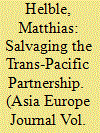|
|
|
Sort Order |
|
|
|
Items / Page
|
|
|
|
|
|
|
| Srl | Item |
| 1 |
ID:
156438


|
|
|
|
|
| Summary/Abstract |
This paper provides an overview of the operational implementation of negative interest rates in Europe and Japan. Drawing attention to the fact that there is precedent for negative policy rates and negative money market rates, the paper addresses conceptual issues and summarizes measures which define negative interest rate policy. Based on detailed institutional analysis and an examination of the interaction of interest rate policies with balance sheet policies, it is argued that there exists substantial heterogeneity in the purpose, design, and operational specificities of negative interest rate policies across economies, with significant consequences for effective market rates, private sector funding conditions, and expectations. Summarizing transmission channels of negative rates, benefits, and risks of the policy, the paper calls attention to potential adverse effects resulting from the interaction of negative interest rates with tighter liquidity and capital standards adopted since the Global Financial Crisis.
|
|
|
|
|
|
|
|
|
|
|
|
|
|
|
|
| 2 |
ID:
156441


|
|
|
|
|
| Summary/Abstract |
Faced with the negative impact of regional and global financial crises, Asian countries have established joint-solution mechanisms over the last two decades in order to better protect themselves from short-term outflows of capital and from currency speculation. Despite some progress being made in regional financial cooperation, especially by the countries of the ASEAN+3 grouping, the overall degree of financial integration within the region remains surprisingly low, however. This contrasts sharply with the keen interest of many Asian countries in gaining a stronger voice within the multinational finance institutions (MFIs), and especially within the International Monetary Fund (IMF). Unable to initiate major governance reforms of the MFIs, Asian countries have not only set up regional support liquidity arrangements but also their own multilateral development banks (MDBs). While the USA and to some extent Japan have tried to prevent a rebalancing of power within the global financial architecture, major European countries have actively supported these changes by becoming founding members of the China-led Asian Infrastructure Investment Bank (AIIB). Taking a New Institutional Economics (NIE) perspective, the paper aims to explain why some regional financial institutions are more attractive for Asian countries than others and why European countries are supporting Asia’s attempt to gain more weight in global financial governance (GFG)—and, thus, contribute to the acceleration of the power shift away from the USA toward emerging Asian economies in general and China in particular.
|
|
|
|
|
|
|
|
|
|
|
|
|
|
|
|
| 3 |
ID:
156436


|
|
|
|
|
| Summary/Abstract |
Asia is Europe’s largest trading partner and EU-Asia trade relations have undergone a rapid change since the global financial crisis. On a global scale, the new multilateral trade agreements such as the now stalled Trans-Pacific Partnership (TPP) involving European Unions’ (EU) major trading partners such as Japan, Singapore and Vietnam also have the potential to change the trade equations. In this paper, we evaluate the new EU trade policy which has been designed to ensure that the EU benefits from the changing global trade scenario and also look at the steps which have been taken by the EU to promote trade relations with its major trading partners in Asia in the predicted ‘Asian century’. We look into the Free Trade Agreements, which are being negotiated with its Asian partners and seek to understand the reasons which have resulted in delays in their signing and negotiations. We evaluate new policies pushed forward by its Asian partners such as the One Belt One Road policy by China and Japan’s policy of securing a large number of trading agreements in the America. Moving ahead, we also shed light on the indirect factors that may influence the success of EU trade negotiations in Asia such as the EU policy on granting China market economy status and the commencement of the ‘Brexit’ process. Lastly, we try to present a list of immediate priorities for EU in Asia, which will ensure that it secures a toehold in trade with the region. All in all, it is shown that the EU has not one and the same approach for all Asian countries but it negotiates flexibly and individually country by country. Because of this “country by country approach” the EU is also not ready to enter into general EU-ASEAN trade negotiations again.
|
|
|
|
|
|
|
|
|
|
|
|
|
|
|
|
| 4 |
ID:
156435


|
|
|
|
|
| Summary/Abstract |
Euro area countries and Japan are confronted with similar challenges. Potential output is on a declining trend in the Euro area, and the decrease started well before the financial crisis. In Japan, low-output growth is a striking feature since many years, despite the unconventional monetary policy stance and numerous fiscal stimulus programs provided by the government. According to a growth accounting exercise based on a Cobb-Douglas production function, the development in both economies can be traced to a weak evolution of TFP. Weak capital deepening is detected especially in the Euro area. Driven by high uncertainty, the willingness of firms to undertake investment is only modest and constitutes the Achilles’ heel for a smooth recovery. Both economies are not well prepared to manage the demographic challenges caused by an elderly population. Given that debt-to-GDP ratios are already at record heights, the scope for further demand-driven policies is limited, especially in Japan. Instead, structural reforms are on the agenda to promote the framework conditions for higher investment and long-run growth in both regions.
|
|
|
|
|
|
|
|
|
|
|
|
|
|
|
|
| 5 |
ID:
156439


|
|
|
|
|
| Summary/Abstract |
The paper analyzes the role of monetary policy for cyclical movements of investment and asset markets in East Asia and Europe based on a Mises-Hayek overinvestment framework. It is shown how the gradual global decline of interest rates has triggered wandering overinvestment cycles in Japan, Southeast Asia, and China. Similarly, it is shown how a one-size monetary policy within the European Monetary Union has not preserved the European Monetary Union from idiosyncratic economic development and crisis because of uncoordinated fiscal policies. With monetary policy crisis management being argued to impede financial and economic restructuring, a timely exit from ultra-expansionary monetary policies is recommended for both East Asia and Europe to reconstitute economic stability and growth.
|
|
|
|
|
|
|
|
|
|
|
|
|
|
|
|
| 6 |
ID:
156440


|
|
|
|
|
| Summary/Abstract |
Our paper investigates the relationship between financial stability and mortgage lending. We estimated the effect of the share of mortgage lending by individual banks (together with some control variables) on two measures of financial stability—the bank Z-score and the non-performing loan ratio—for a sample of 1889 banks in 65 advanced and emerging economies for the period 1987–2014 from the Bankscope database. We specifically compared the behavior of banks in Europe and Asia. We find evidence that an increased share of mortgage lending is positive for financial stability, specifically by lowering the probability of default by financial institutions and reducing the non-performing loan ratio, at least in non-crisis periods, for levels of mortgage shares up to 49–68%. For higher levels of mortgage lending shares, the impact on financial stability turns negative. Also, the occurrence of a banking crisis reduces the diversification benefits associated with mortgage lending. Compared with the base sample, Asian banks show greater financial stability during non-crisis periods, but are more negatively affected by a higher mortgage ratio during crisis periods, while European banks show greater financial stability during non-crisis periods, but are less negatively affected during crisis periods. Finally, a higher level of regulatory quality improves both financial stability measures, but the effects of macroprudential measures are found to be mixed.
|
|
|
|
|
|
|
|
|
|
|
|
|
|
|
|
| 7 |
ID:
156434


|
|
|
|
|
| Summary/Abstract |
The global financial and economic crisis (GFEC) that started in 2007 triggered a global economic downturn, which was particularly marked in Europe as well as the United States. Asia weathered the economic shock relatively well, although the knock-on transmissions through trade and financial channels still caused a slowdown of export demand and economic growth in many countries within the region. The consequences of the GFEC are still felt today. Economic growth across the world remains weak and prospects uncertain, while the need for structural changes in the real economy and the financial sector has increased.
|
|
|
|
|
|
|
|
|
|
|
|
|
|
|
|
| 8 |
ID:
156437


|
|
|
|
|
| Summary/Abstract |
The high hopes that the Trans-Pacific Partnership (TPP) would open up trade across the Pacific were dashed by the decision of the new US Government under President Trump to withdraw from the agreement in January 2017. Despite being controversial, the TPP had been recognized as an agreement that substantially updates and extends international trade rules responding to new technological developments and economic realities. It was thus lauded by some as the first true twenty-first century trade agreement. The United States’ withdrawal from TPP gives the agreement an uncertain future. Yet, we argue in this paper that some achievements of the TPP might not be lost. The TPP offers important lessons for other ambitious regional trade deals both in terms of process and content. Furthermore, several chapters of the TPP can become blueprints for ongoing and upcoming negotiations at the multilateral level. A one-to-one transposition of TPP provisions into the multilateral trade agreement is unlikely, yet certain provisions could serve as valuable inspiration for future multilateral trade talks.
|
|
|
|
|
|
|
|
|
|
|
|
|
|
|
|
|
|
|
|
|